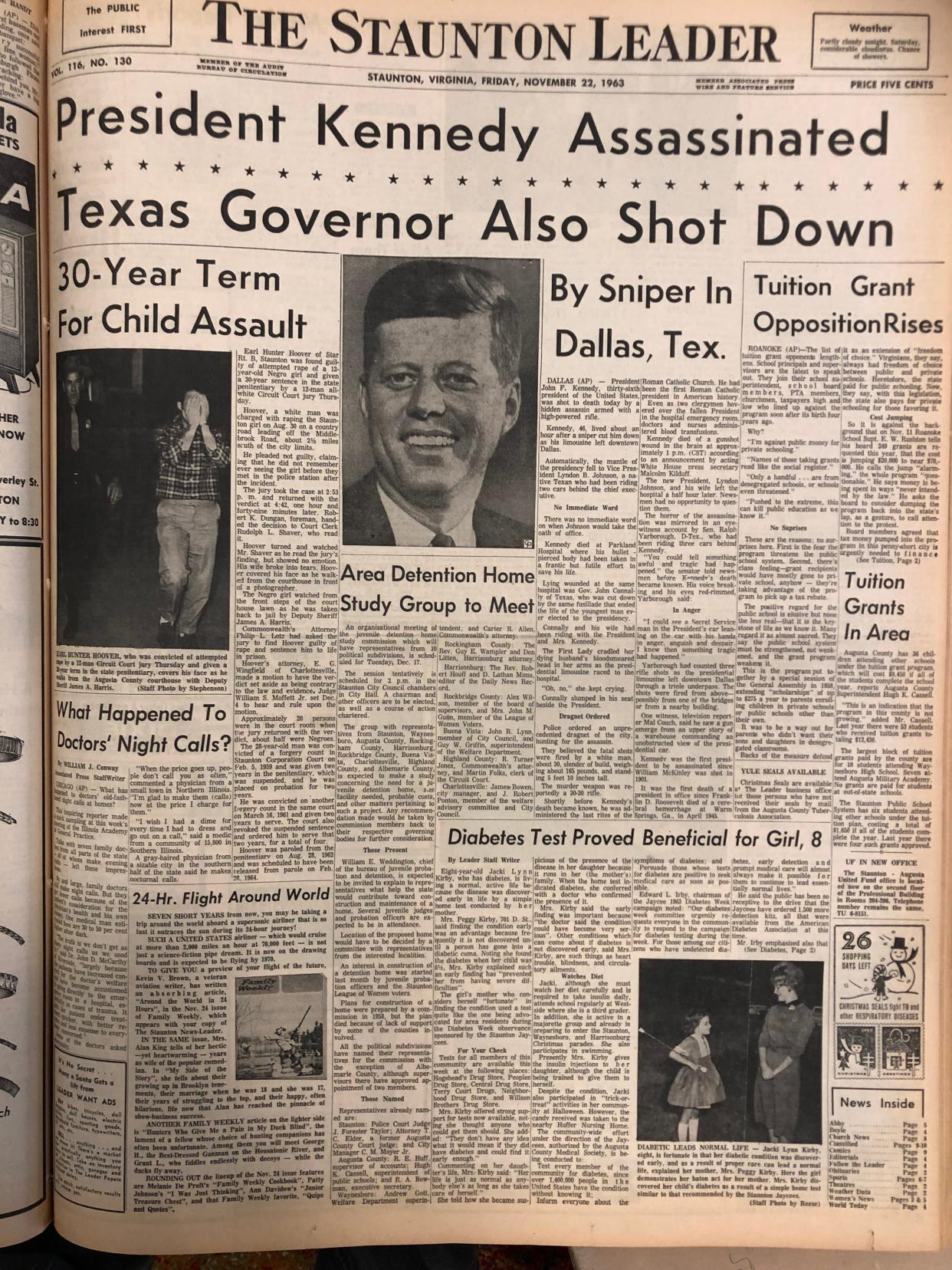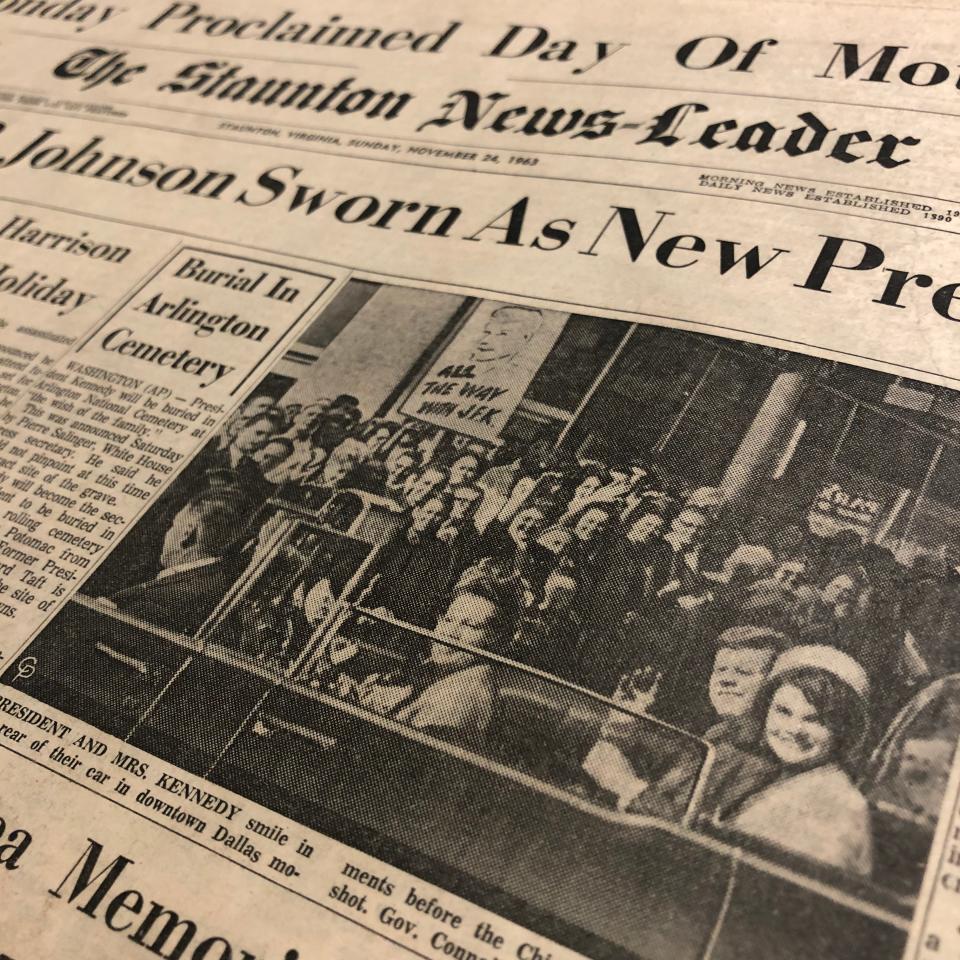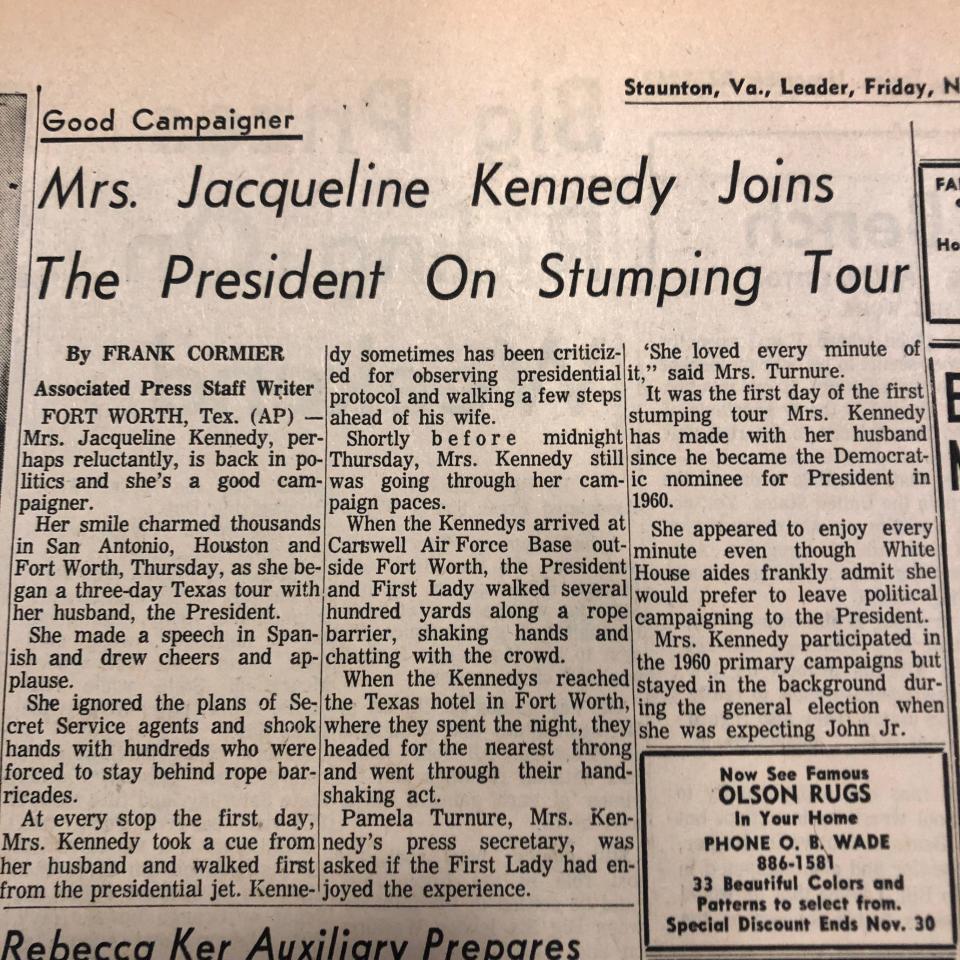Kennedy assassination: The horror, the headlines, and the hidden story that marked the end of an era

- Oops!Something went wrong.Please try again later.
- Oops!Something went wrong.Please try again later.
- Oops!Something went wrong.Please try again later.
Sixty years ago, Nov. 22 fell on a Friday before Thanksgiving week. And just after noon in Dallas, President John F. Kennedy was shot and killed while riding in a motorcade alongside his wife.
The news moved fast, even in those days, and hours later the afternoon edition of The News Leader read, "President Kennedy Assassinated" across its front page. The page printed a stock photo of Kennedy, and a brief story, "By Sniper In Dallas, Tex." which even for a news brief thrown into the mix at the last minute, contained the astonishment, grief and anger of a nation.
"I could see a Secret Service man in the President's car leaning on the car with his hands in anger, anguish and despair," Sen. Ralph Yarborough, D-Texas, was quoted as telling the Associated Press. "I knew then something tragic had happened."
The story said that police "believed the fatal shots were fired by a white man, about 30, slender of build, weighing about 165 pounds and standing 5 feet 10 inches tall."
The president was dead by 1 p.m. after a "frantic but futile effort to save his life."

'In this dark hour'
The News Leader did not publish on Saturdays, and the next edition reported the swearing in of Lyndon Baines Johnson, and the declaration of a Day of Mourning on Monday, Nov. 25.
Locally, Staunton police officers wore black crepe on their left shoulders to honor the fallen leader, according to a story in Sunday's paper. "Both Staunton and Augusta Military Academies cancelled their customary Sunday afternoon dress parades." Mary Baldwin College scheduled a memorial service at 10:30 Monday morning for students, staff and faculty. Students of the local private school Stuart Hall had already held their own memorial service Friday evening.
City Hall released a statement from Mayor E. Lewis Knowles. "Like the people of this nation and the people of the free world, the people of Staunton bow their heads in deep sorrow and deep sympathy today," it began, and closed with "Be of strong courage in this dark hour."
"Photographs Connect Lee Oswald With Gun Used in Kennedy Slaying," appeared below the fold, the first mention of Oswald locally. The story, written by AP's Peggy Simpson, raised the question of whether Oswald may have been aiming for Texas Gov. John Connally, who was wounded in the attack, but just as quickly dismissed it with a comment from Dallas police chief Jesse Currey.
"I think his actual target was the President. I say this because he hit the President twice from about a 75-yard distance on a slant, and apparently he was an expert marksman."
Coverage continued inside the paper. On page 6 a headline read, "Kennedy's Father Takes News Well" and another, "Moscow Radio Claims Communists Blamed."
"Sports Activity Comes To A Standstill," according to the banner across the top of the sports page.
And on page 16 a long story laid out what police had reported to the press about Lee Harvey Oswald's activities leading up to the shooting. "He was a loner and kept pretty much to himself all his life. He held radical views, but wasn't regarded as a troublemaker. Deep within, his inverted personality became imbued in early youth with an alien ideology, enunciated a century ago by Karl Marx," the story began.
Subheadlines included "Lonely, Introverted," "Applied for Passport," "Raises Suspicion" and, finally, "Didn't Explain."
Beside the story is a photo of the First Lady brushing back her hair as she is applauded by a Latin American citizens group in Houston the previous day. She had spoken to the group in Spanish. Behind her stands her smiling husband.

The 'good campaigner' story that slipped by the editors on Nov. 22
When News Leader editors hurried to prep the front page with the shattering news of Kennedy's death, they probably were not thinking of the light and breezy story about the First Lady which was already set on one of the inside pages. Under the deck "Good Campaigner," the story by AP staff writer Frank Cormier breezily noted, "Mrs. Jacqueline Kennedy, perhaps reluctantly, is back in politics and she's a good campaigner."
"Her smile charmed thousands in San Antonio, Houston and Fort Worth, Thursday, as she began a three-day Texas tour with her husband, the President.
"She made a speech in Spanish and drew cheers and applause.
"She ignored the plans of Secret Service agents and shook hands with hundreds who were forced to stay behind the rope barricades."
The First Lady's press secretary was quoted as saying, "She loved every minute of it."
The story, so out of place in tone after the front page headlines, stands as a monument, and perhaps a tombstone, to a different time, the time before our president was killed by one of our own, and with it a way of reporting on politics as well. Before the story had even reached readers, the world had changed.
—Jeff Schwaner is the Editor of The News Leader in Staunton and The Progress-Index in Petersburg. Reach him at jschwaner@newsleader.com.
This article originally appeared on Staunton News Leader: Kennedy assassination: The horror, the headlines, and the hidden story that marked the end of an era

